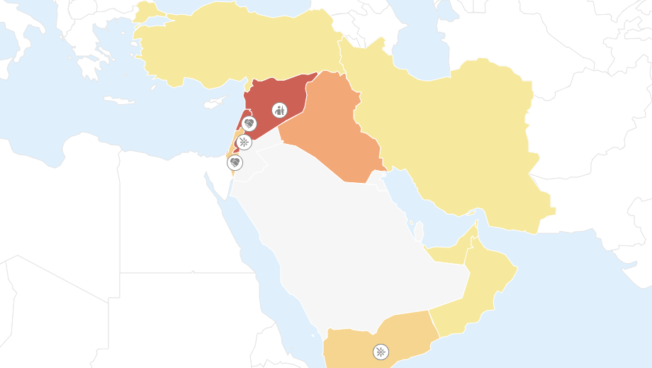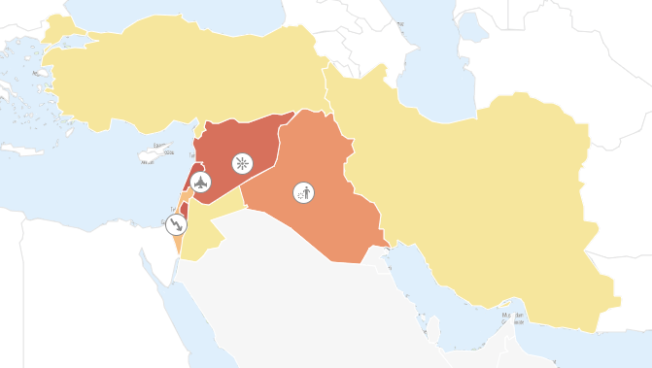Regional Overview
Middle East
November 2024
Posted: 6 December 2024
In this Regional Overview
- Gaza: IDF expands ground operations in North Gaza while overall violence decreases across the Strip
- Lebanon and Israel: A ceasefire agreement is reached after 14 months of fighting
- Syria: Rebel factions launch large-scale military operations against the Syrian regime
- Yemen and Red Sea: Attacks remain focused on Israel, while Red Sea operations decline
Gaza: IDF expands ground operations in North Gaza while overall violence decreases across the Strip
In November, Israel Defense Forces (IDF) airstrikes and shelling across the Gaza Strip decreased by 11% compared to the previous month, and reported fatalities declined by 25%. Ground operations in Jabaliya Camp and surrounding areas also declined in intensity, with fewer clashes between Palestinian armed groups and Israeli troops. However, Israeli forces expanded their operations into the Bayt Lahiya area, where heavy fighting with Hamas and other groups resulted in eight of the 14 Israeli soldier fatalities reported in North Gaza. Israeli artillery and warplanes continued targeting Jabaliya and Bayt Lahiya, striking hospitals and shelters for displaced people. Kamal Odwan Hospital and the Indonesian Hospital were hit in several incidents, causing fatalities and injuries, including among healthcare workers and patients. Israeli demolitions also continued in North Gaza, reportedly creating a nine-kilometer military corridor that separates it from Gaza City.1Benedict Garman, Nick Eardley, and Matt Murphy, ‘Israel building new military dividing line across Gaza, satellite images suggest,’ BBC, 20 November 2024
On the diplomatic front, Hamas and Israel resumed indirect hostage and ceasefire deal negotiations in Gaza in late November. Israel is likely to attempt to leverage its ongoing military operations in North Gaza and the ceasefire agreement with Hezbollah — which has decoupled Hezbollah’s attacks on northern Israel from the Gaza war — to weaken Hamas’s bargaining position.
Lebanon and Israel: A ceasefire agreement is reached after 14 months of fighting
On 27 November, Israel and Hezbollah reached a ceasefire after nearly 14 months of fighting, triggered by the Lebanese Shiite armed group’s attacks on Israeli interests in solidarity with Gaza. The deal was reached following a limited IDF ground invasion into southern Lebanon and an intensified air campaign that remained at heightened levels throughout November despite decreasing by over 20% compared to the preceding month. Exerting additional pressure, particularly in the week leading up to the ceasefire, Israel intensified airstrikes on the Lebanese capital, targeting at least three different areas in downtown Beirut for the first time since October 2023. IDF ground troops also advanced, reaching the Litani River in the eastern sector and engaging in intense clashes with Hezbollah forces in the villages of al-Bayda and Chamma near the western coast, as well as in the strategic town of Khiyam. Meanwhile, Hezbollah’s drone and rocket attacks targeting Israel decreased by 46% compared to the preceding month. However, in the lead-up to the agreement, Hezbollah escalated its operations, launching up to 250 projectiles on 24 November alone.2France 24, ‘Hezbollah fires about 250 rockets and other projectiles into Israel in massive barrage,’ 24 November 2024
While relative calm was restored along the Lebanese-Israeli border following the ceasefire, the situation remains fragile. The IDF announced its forces would stay in southern Lebanon until the Lebanese Armed Forces take control of the area during the initial 60-day transitional period of the ceasefire. Between 27 and 30 November, over 50 violent incidents were reported in Lebanon, primarily involving IDF shelling, along with some airstrikes. Most notably, Israel carried out several airstrikes in southern Lebanon on 30 November, killing two people and injuring six others. The IDF stated that the strikes, which it said it conducted in response to ceasefire violations, had hit a Hezbollah rocket-launcher facility in Sidon and a vehicle in southern Lebanon carrying rocket-propelled grenades, ammunition, and military equipment.3Al Jazeera, ‘Israeli attacks kill two, wound six in southern Lebanon despite ceasefire,’ 30 November 2024
Syria: Rebel factions launch large-scale military operations against the Syrian regime
On 27 November, Hayat Tahrir al-Sham (HTS) and its allies launched an offensive operation under the newly formed Military Operations Command. Dubbed Deterrence of Aggression,4The Syrian Observer, ‘Operation Deterrence of Aggression: Opposition Forces Redraw the Map in Northern Syria,’ 30 November 2024 it was carried out in regime-held areas in Aleppo, Idlib, and Hama. The rapid and extensive advance of the offensive resulted in a significant collapse of the frozen frontlines established by the 2020 Russian-Turkish truce. Between 27 and 30 November, the Military Operations Command and other opposition factions captured the entire Idlib province and, most notably, Syria’s second-largest city, Aleppo, which had been under regime control since December 2016. During this period, over 200 towns and villages in Aleppo and Idlib provinces fell under rebel control, reshaping the balance of power in northern Syria. The Military Operations Command also gained ground in the Hama countryside, taking control of 20 localities, and forces advanced toward Hama city along the M5 highway. Most territorial gains occurred peacefully as regime forces withdrew without confrontation.
The Turkish-backed Syrian National Army (JWS) has also joined the fighting. On 30 November, it announced the launch of Operation Dawn of Freedom5Daily Sabah, ‘ Syrians return to Tal Rifaat liberated from PKK/YPG terrorists,’ 3 December 2024 with the stated objectives of intercepting Syrian Democratic Forces and People’s Defense Units supply networks and completing the corridor connecting the Turkish-controlled city of al-Bab with the Kurdish-controlled city of Tall Refaat.6Turkiye Today, ‘Syrian National Coalition PM: Operation Freedom Dawn aims to cut PKK supply lines,’ 30 November 2024 Following the withdrawal of regime forces from Aleppo, Kurdish forces mobilized in some of the areas in the governate, with some reports suggesting they aimed to create a corridor linking Menbij, Tall Refaat, and the Kurdish-controlled neighborhoods in Aleppo city.7Tugba Altun, ‘ Syrian National Army launches operation against PKK/YPG terror group,’ Anadolu Agency,’ 1 December 2024 The JWS captured at least 24 cities on the first day of the operation, primarily in regime-controlled areas of Aleppo.
Meanwhile, government and Russian forces intensified their airstrikes and shelling on rebel-held areas, including newly captured areas in Aleppo, Idlib, and Hama. Between 27 and 30 November, ACLED records more than 50 airstrikes and 40 shelling events that reportedly killed over 70 people, mostly civilians. Though the rebels’ operation surprised many, some observers have been raising alarms of a potential offensive by HTS and other rebel factions for months.8Syria TV, ‘Growing Signs and on the Ground Movements…Is Northern Syria on the Verge of a New Offensive?’ 31 October 2024 Since early September, regime forces and their allies have been increasing their attacks on rebel-held areas, with a surge in their use of suicide drones to target rebel areas. In September, ACLED records 234 aerial and shelling strikes targeting HTS and JWS-held areas, including 42 suicide drones, double the number recorded for the previous month. The number of strikes increased by 75% in October and continued throughout November, with the use of suicide drones reaching its highest point in the near three-month span.
Nevertheless, the rebels’ successful advances showcase advanced military planning and rapid maneuvers used to outpace regime defenses. Key to the operation’s success were covert attacks behind enemy lines, which caught government forces unprepared and prompted their withdrawal from extensive territories. The timing of the offensive was likely influenced by reduced Russian support for the regime and Hezbollah’s constraints amid its conflict with Israel. Early successes saw the opposition doubling their territorial control from 11% to 22% in just five days,9Al Jazeera, ‘With Maps…The Syrian Opposition Controls 22% of Syrian Territory,’ 3 December 2024 capturing strategic airports and military sites. These developments may signal a turning point in the conflict, with potential implications for both regional dynamics and future peace settlements. Yet, the success of these operations and the extent to which they will define the near future of the region will partly depend on the responses of the Syrian regime and the various foreign actors directly and indirectly involved in the conflict.
Yemen and Red Sea: Attacks remain focused on Israel, while Red Sea operations decline
November 2024 marked the first anniversary of the Houthis’ attacks on maritime trade in the Red Sea. Early in the month, the Houthi military spokesperson announced plans to expand military targets further.10X @AmeenHa2024yan, 3 November 2024 Despite these statements, attacks on commercial ships remained scarce, comparable to the record low observed in September. Tit-for-tat confrontations with the US continued at a slow pace, while attacks on Israel stayed above the 2024 monthly average.
Since September, the bulk of Houthi attacks have targeted Israel, in line with the group’s declared “fifth phase of escalation.”11Ansarollah, ‘The Israeli aggression on Yemen will not restore its deterrence, and the “Israelis” should be more afraid and worried than ever before,’ 21 July 2024 Between November 8 and 22, the Houthis claimed responsibility for five missile and drone attacks, three of which were intercepted by Israeli forces.12The remaining two attacks are uncorroborated by non-Houthi sources. Meanwhile, US airstrikes on critical infrastructure in Houthi-controlled territories continued at high levels. ACLED records at least 12 air-/drone strikes conducted by the US against Houthi targets between 8 and 12 November. The latest wave of strikes came shortly after three Houthi attacks on US warships in the Red Sea. On 11 November, the group launched drones and missiles at the USS Stockdale and USS Spruance near Bab al-Mandab, all of which were intercepted. They also claimed to target the USS Abraham Lincoln in the Arabian Sea, which US authorities denied. These are the first confirmed Houthi attacks targeting US military ships in the international waters surrounding Yemen since 5 August.
Meanwhile, the Houthis targeted only one commercial ship, the Turkish-owned, Israel-linked bulk carrier Anadolu.13Another commercial ship was attacked on 12 November, but the Houthis did not claim the attack. Several factors arguably drive this decline in Houthi Red Sea attacks. Among these, continuous US airstrikes likely weakened the group’s military capacity, and the Houthis may seek to decouple the Red Sea conflict from the broader Gaza crisis to advance a peace deal with Saudi Arabia. At the same time, internal dynamics suggest the Houthis are shifting focus toward reinforcing their frontlines with the pro-Internationally Recognized Government factions in Yemen, with reports of increased weapon transfers, new fortifications, and movement of troops in the south of al-Hudayda governorate.14Al Sahil Al Gharbi, ‘Al Hudaydah minded: the Houthis close the path to peace,’ 17 November 2024; Al Mashhad Al Yemeni, ‘Houthis move quickly in Sanaa and its environs and sources reveal why!’ 12 November 2024; Al Mashhad Al Yemeni, ‘The Houthis mobilize their forces toward Al Hudaydah and empty prisons and the port in case of military confrontations,’ 5 November 2024 The Houthis began attacking ships in November 2023 in response to Israeli military operations in the Gaza Strip and in purported solidarity with Palestinians.
For more, see the Red Sea attacks interactive map created as part of the Yemen Conflict Observatory.
See More
See the Codebook and the User Guide for an overview of ACLED’s core methodology. For additional documentation, check the Knowledge Base. Region-specific methodology briefs can be accessed below.
Links:
For additional resources and in-depth updates on the conflict in Yemen, check our dedicated Yemen Conflict Observatory.







